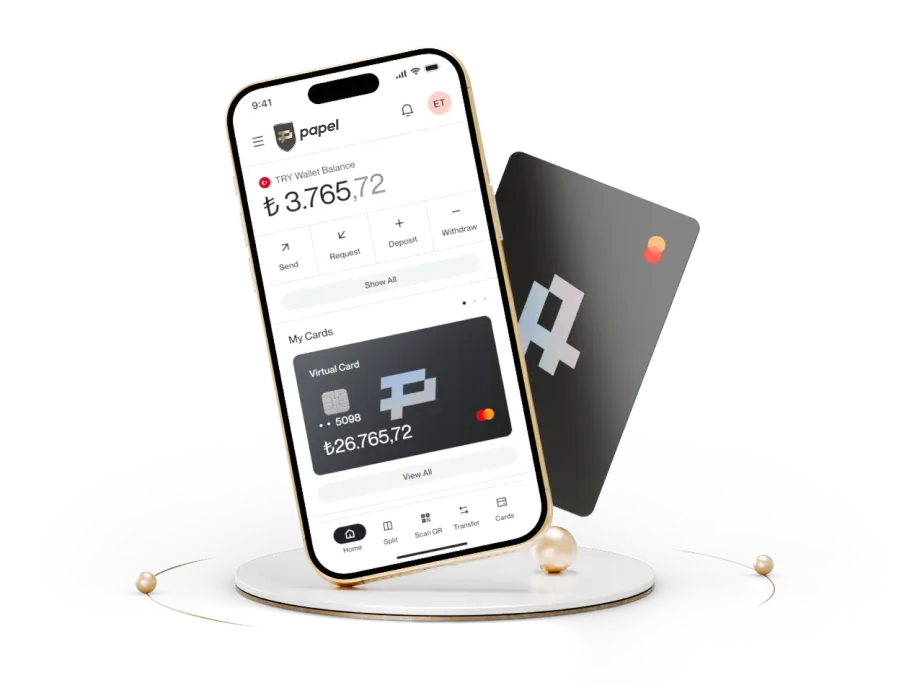Para Transferi: FAST, Swift, EFT ve Havale Farkları Nelerdir?
Hem ticaret hem de günlük yaşamımızda paranın bir yerden başka bir yere gitmesi her geçen gün daha da önemli hale geldi. Yurt içi para transferinin yanı sıra uluslararası para transferleri de teknolojik imkanların gelişmesi ve global ticaretin yaygınlaşması ile önem kazandı. Hem yurt içi hem de yurt dışı para gönderme işlemlerinde kullanılabilecek çok fazla yöntem ve kurum olması, günlük hayatımızın her alanında kullandığımız para transferini karmaşık hale getirebiliyor. Bu yazıda en temel para transfer yöntemlerini, ilgili yöntemlerin limit ve gönderim ücretlerini, varsa zaman sınırlamalarını ve her yöntemin ortalama olarak ne kadar zaman aldığını inceleyeceğiz.
Önce terimlerden başlayalım. Yurt içi ya da yurt dışına para gönderir ya da alırken bilmeniz gereken bazı terimler şunlar:
IBAN (Uluslararası Banka Hesap Numarası)Yurt içi ve uluslararası para transferlerinde kullanılan, her hesap için oluşturulmuş benzersiz bir hesap numarasıdır.
Hesap NumarasıBir e-cüzdan ya da banka hesabının benzersiz tanımlayıcısıdır, her müşteriye özel olarak verilen numaradır.
SWIFT KoduSociety for Worldwide Interbank Financial Telecommunication (Bankalararası Finansal Telekomünikasyon Derneği) kelimesinin baş harflerinden oluşan SWIFT, bankaların uluslararası para transferlerini işlemek için kullanılan benzersiz bir kimlik kodudur.
VirmanAynı kişiye ait hesaplar arası yapılan iç transfer işlemidir ve genellikle aynı banka içinde yapılır.
E-cüzdanE-cüzdan veya elektronik cüzdan, finansal işlemleri elektronik olarak yönetmek ve dijital ödeme yapmak için kullanılan bir çevrimiçi araçtır. E-cüzdanlar, kullanıcıların ödeme bilgilerini güvende tutmalarına yardımcı olmak için güvenlik önlemleri sunar.
EFT (Elektronik Fon Transferi)EFT, bankalar arası elektronik para transferi anlamına gelir. Farklı bankalar arasında veya aynı banka içindeki farklı hesaplar arasında para transferi yapmayı sağlar.
HavaleHavale, aynı banka içindeki farklı hesaplar arasında yapılan elektronik para transferidir. Farklı bankalar arasında değil, aynı banka içinde gerçekleşir.
FAST (Fonların Anlık ve Sürekli Transferi)Türkiye'de anlık para transferi sağlayan bir sistemdir. EFT gibi sadece mesai saatleri içinde değil, 7 gün 24 saat limitler dahilinde transfere imkân tanır.
İşlem ÜcretiBankalar veya finansal kurumlar tarafından yapılan transfer işlemleri karşılığında alınan ücret veya komisyondur.

Havale Nedir? Nasıl Yapılır?
Havale işlemi, yurt içinde aynı bankadaki bir hesaptan başka bir hesaba para gönderme işlemidir. Havale ile para transfer işlemi banka şubelerinden, ATM'lerden veya dijital kanallardan gerçekleştirilebilir. Havale ile yapılan para gönderme işlemlerindeki işlem ücreti ise bankadan bankaya farklılık gösterebilir. Bazı bankalar havale edilen tutara göre işlem ücreti alırken, bazı bankalar işlem ücreti almayabilir.Havale, aynı banka içindeki farklı hesaplar arasında yapıldığı için genellikle hızlıdır ve ücretleri diğer para transfer yöntemlerine göre daha düşüktür.
EFT (Elektronik Fon Transferi)
EFT, havaleden farklı olarak bir banka hesabından başka bir banka hesabına para göndermeye yarayan hizmettir. EFT ile bankalar arası fon transferleri kolaylaşır. EFT işleminde paranın bir diğer hesaba ulaşma süresi bankalar arası yoğunluk ve teknik detaylar nedeniyle değişiklik gösterebilir. Türkiye'de EFT işlemleri genellikle mesai saatleri içerisinde gerçekleştirilebilir. EFT ücreti ise gönderen tarafından ödenir.
FAST
FAST (Fonların Anlık ve Sürekli Transferi), havale ve EFT'ten farklı olarak kolay para transferi için T.C. Merkez Bankası’nın sunduğu bankalar arası anlık ödeme sistemidir. FAST sayesinde, farklı bankalar arasında para transferleri 7 gün 24 saat, çok daha hızlı şekilde yapılabilir. 2025 yılı itibarıyla, FAST sisteminde işlem başına uygulanacak üst limit 100.000 TL’dir. FAST-TR Karekod kullanılarak gerçekleştirilecek dinamik doğrulamalı iş yeri ödemelerinde ise tek seferde 250.000 TL’ye kadar işlem yapılabilir. FAST ile yapılan para transferlerinden alınan işlem ücreti ise bankadan bankaya farklılık gösterir.FAST, havale ve EFT arasındaki farkları şöyle özetleyebiliriz: Havale aynı banka içinde farklı hesaplar arasındaki para transferini, EFT ise farklı bankalar arasında yapılan para transferlerini ifade eder. FAST ile EFT arasındaki fark ise işlem limiti ve işlem süresidir.EFT'de limit banka ve müşteriye göre değişirken, FAST limiti TCMB tarafından belirlenir. Ayrıca EFT sadece mesai saatleri içerisinde para transferine imkân tanır, FAST ile 7/24 para göndermek ve almak mümkündür.
SWIFT Nedir?
SWIFT, Society for Worldwide Interbank Financial Telecommunication kelimelerinin baş harfleri kullanılarak oluşturulan bir kısaltmadır. Tüm dünyadaki bankalar arasında elektronik fon transferi yapmayı sağlar. 1973 yılında kurulan ve merkezi Belçika'nın Brüksel şehrinde bulunan SWIFT sistemine, dünya genelinde 11.000'den fazla finansal kuruluş ve banka üyedir.
SWIFT, döviz cinsinden ticari ödemelerin yanı sıra yurt dışına para transferi için kullanılan uluslararası bir yöntemdir. Her bankanın kendine özel bir SWIFT kodu bulunur ve bu kodlar, bankalar arasındaki para transferlerini kolaylaştırır. SWIFT kodları 8-11 karakterden oluşur ve bankanın yerini, ülkesini, şubesini tanımlayan bilgileri içerir. Bu işlemler genellikle bankaların şubeleri, internet bankacılığı veya mobil uygulamaları aracılığıyla gerçekleştirilir.
SWIFT İşlemleri Ne Kadar Sürer? İşlem Ücretleri Ne Kadardır?
Genel olarak, SWIFT aracılığıyla yapılan uluslararası para transferleri birkaç saat ila birkaç gün sürebilir. İşlem süresi, belirli bir transferin özel koşullarına ve gönderici ile alıcı bankalar arasındaki faktörlere bağlı olarak değişir. Bu nedenle, her transferin işlem süresi farklı olabilir. İşlem ücreti de aynı şekilde bankanın politikasına ve tutara bağlı olarak farklılık gösterir.
SWIFT İşlem Limiti Nedir?
SWIFT sisteminin kendisi doğrudan işlem limitleri belirlemez. Bunun yerine limitler, kullanılan banka veya finansal kurumun politikalarına, müşterinin hesap türüne ve diğer faktörlere bağlı olarak değişir.
Hangi Para Transferi Yöntemi Daha İyi?
En iyi, en hızlı ya da en ucuz para transferi yöntemi, kişiden kişiye ya da duruma göre değişir. Yurt dışına para gönderecek biri için ihtiyaçlar ve beklentiler farklıyken, üniversite okuyan çocuğuna cep harçlığı göndermek isteyen bir babanın beklentileri farklıdır. Bu nedenle, senin ihtiyaçlarına en uygun para transfer yöntemini seçerken göz önünde bulundurman gerekenler şunlar:
Gönderici ve Alıcının Konumu:
Para transferi yaparken gönderici ve alıcının bulunduğu konum büyük bir öneme sahiptir. Eğer gönderici ve alıcı farklı ülkelerde bulunuyorsa, uluslararası para transferi yöntemi seçmek gerekebilir. Bu, farklı ülkelerin para transferi düzenlemeleri ve döviz kuru farklılıkları göz önüne alındığında önemlidir.
Gönderilecek Tutar:
Para transferi yapacağınız tutar, işlem ücretini etkileyebilir. Bazı para transfer yöntemleri, daha büyük tutarlar için daha düşük ücretler sunabilir. Bu nedenle gönderilecek tutarı göz önünde bulundurarak en ekonomik seçeneği belirlemek önemlidir.
İşlem Hızı:
Para transferi işleminin hızı, aciliyeti olan durumlar için önemlidir. Bazı yöntemler, diğerlerine göre daha hızlıdır. Acil para transferleri için daha hızlı işlem yapabilen yöntemleri tercih etmek gerekebilir.
Güvenlik:
Para transferi işlemleri güvenlik açısından büyük önem taşır. Özellikle uluslararası transferlerde güvenli bir yol seçmek önemlidir. Güvenlik konusunda güçlü ve saygın bir finansal kurum veya servis sağlayıcısını tercih etmek, paranızın güvende olduğundan emin olmanıza yardımcı olur.
Papel ile 7/24 Ücretsiz Para Gönder
Papel ile 7/24 ücretsiz para gönderebilir, hızlı ve kolay para transferinin tadını çıkarabilirsiniz. Detaylar için tıkla.İşlem ücretlerinden, yavaş transferlerden ve karmaşık işlemlerden uzak, yepyeni bir finans deneyimi için Papel’i keşfet.

